All things Histone Deacetylase (HDAC) and DNA Methyl Transferase (DNMT) inhibitory - reversing epigenetics from metabolic insults
-
@Mauritio said:
baicalin can ameliorate neuropathic pain by suppressing HDAC1 expression https://pubmed.ncbi.nlm.nih.gov/23684218/
Yet it enhances HDAC2 and inhibits histone demethylase (LSD1) at an IC50 of 3.01μM.
The LSD1 inhibition can be either a welcome or unwelcome dual-function.
https://pubmed.ncbi.nlm.nih.gov/22421405/
https://pubmed.ncbi.nlm.nih.gov/27814566/
I wouldn't know when to use baicalin and when not beside the neuropathic pain scenario.
There has actually been research into a series of dual HDAC and LSD1 inhibitors via conjugating the LSD1 inhibitor tranylcypromine to various o-aminoanilide and hydroxamic acid-based HDAC inhibitors, preferably with vorinostat by Duan et al., 2017 and with entinostat by Kalin et al., 2018.
Domatinostat is by itself already an class I HDACi and LDS1i. Those bifunctional HDACi+LDS1i compounds appear to be significantly more effective against cancer.Specifically against cancer baicalin works through a different pathway: Inhibition of hexokinase II which is located at the outer mitochondrial membranes and provides the cancer cell's excessive glucose needs.
-
Apigenin and the congeneric luteolin are potent class I HDACi, especially strong against HDAC2 and HDAC8.
Much less affinity to HDAC7, which would be targeted by class IIa HDACi (HDAC4/5/7/9).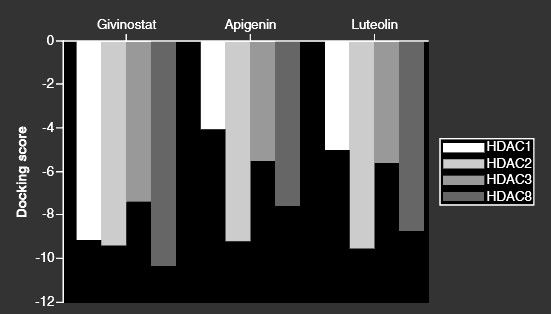
[The more negative the value of docking score, the higher is the affinity of ligand toward receptor.]On a simple by-weight calculation this could convert to 100-150mg apigenin/day for a human:
"Moreover, oral intake of defined flavone (20 and 50 μg/mouse/day) for more than 8-week period has revealed a substantial reduction in tumor growth of PC-3 xenografts in athymic nude mice [41]."
From: In silico approaches for investigating the binding propensity of apigenin and luteolin against class I HDAC isoforms
Luteolin, promising a very good safety profile, may alleviate hyperalgesia, chronic inflammatory or neuropathic pain. The authors make no mention of HDAC or epigenetics at all but point to luteolin's strong anti-inflammatory and antioxidant properties. Ultimately it may well be due to inhibitions of HDAC, similar to and in line with the aforementioned baicalin:
Luteolin: A promising natural agent in management of pain in chronic conditions
-
This in-silico modelling shows butyric acid being also an inhibitor of class IIa (HDAC7). It also reveals that phenylbutyrate does indeed exert stronger action:
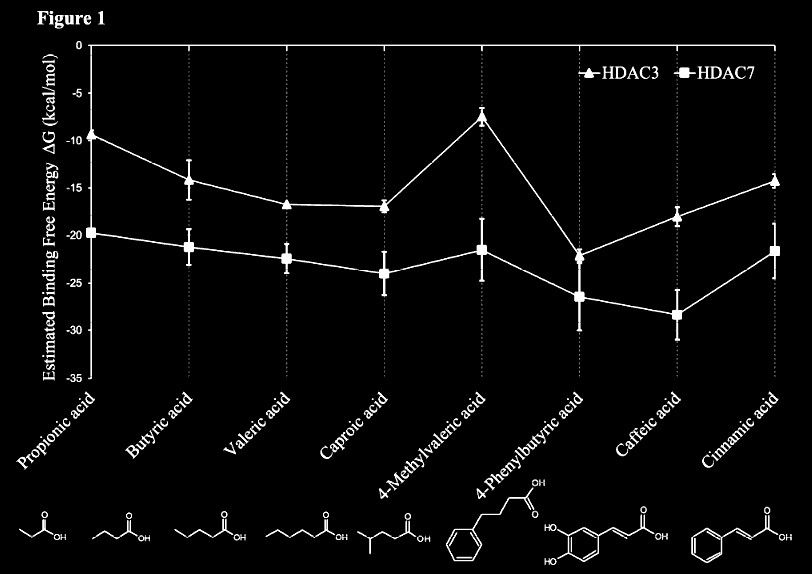
From: In Silico and in Vitro Interactions between Short Chain Fatty Acids and Human Histone Deacetylases
-
I've seen apicidin [cyclo(N-O-methyl-l-tryptophanyl-l-isoleucinyl-d-pipecolinyl-l-2-amino-8-oxodecanoyl)] in a graphic put into the same HDACi group of cyclic peptides along with romidepsin and briefly followed up on that one:
It appears apicidin is orally and parenterally effective in vivo against protozae like plasmodium (malaria) by inducing hyperacetylation of histones in treated parasites. Potentially also active against toxoplasma, cryptosporidia etc.
"Other known HDA inhibitors were also evaluated and found to possess antiparasitic activity, suggesting that HDA is an attractive target for the development of novel antiparasitic agents."
Apicidin: A novel antiprotozoal agent that inhibits parasite histone deacetylase
"Treatment of P. falciparum cells with 70nM of apicidin at these three developmental stages resulted in ∼90% reduction of growth (IC90)"
Histone Deacetylases Play a Major Role in the Transcriptional Regulation of the Plasmodium falciparum Life Cycle
-
Looked into the effect of sodium butyrate on causing senescence / stopping cells proliferate. it can do that to normal fibroblasts (even tho showed increased wound healing). but effect is selective
pretty good one showing this helps recovery after brain injury , https://pmc.ncbi.nlm.nih.gov/articles/PMC2726719/#S10
during continued poor blood flow to the brain it helped restore brain cells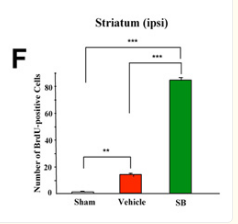
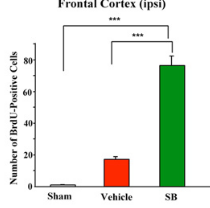
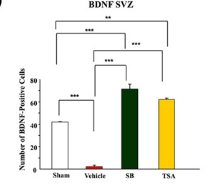
Day 14 after injury
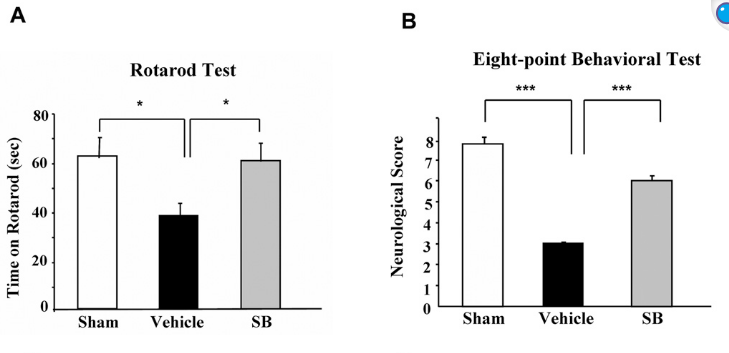
-
@cs3000 said:
Looked into the effect of sodium butyrate on causing senescence / stopping cells proliferate. it can do that to normal fibroblasts (even tho showed increased wound healing). but effect is selective
I can't remember which study and which HDACi substance but the other day I also read a paper on wound healing and how, in vitro, almost every single crucial stage of cell line and activity suggested impairments of the different stages of wound closure - which overall however didn't materialize as wound healing was improved and "more structured".
I'm still wondering on what to stack or balance HDACi with to also promote proliferation of progenitor cells, though. Maybe aKG? Which may also induce OCT4, SOX2, KLF2 for reversal to pluripontent stem cells (iPSC)? -
In Ray Peat's newsletter "Epigenetics, sickness-aging, and changing science" (2014 01), which IMO starts off as a rather tiring albeit not unjustified rant, HDACi emerge as a significant factor against endometriosis and excessive menstruational symptoms (page 5):
- Although every organ seems to be renewed
(more or less regularly) by the maturation of stem
cells, the lining of the uterus is interesting because
it has a monthly cycle, in which stem cells multi-
ply actively during part of the month, and then
enter a phase of maturation, with the ability to
support a pregnancy. In the proliferative phase,
cells are dominated estrogen, and in the
maturation phase, by progesterone. During the
estrogen phase genes are massively silenced by the
HDAC enzymes, and during the progesterone
phase, those HDAC enzymes are inhibited.
Prolonged excessive exposure to estrogen with
deficient influence of progesterone can lead to the
development of endometriosis and endometrial
cancer. The combination of progesterone and
other HDAC inhibitors is effective in treating
endometriosis and endometrial cancer, and proba-
bly in other tumors, such as neuroblastomas (Atif,
et aI., 2011) and lymphomas. Cyproheptadine,
known mainly as an antiserotonergic antihista-
mine, is also an HDAC inhibitor, helpful in
treating mantle cell lymphoma (Paoluzzi, et al.,
2009). Aspirin, with an acetylating effect that has
been considered to be harmful, appears to activate
a histone, synergizing with a variety of HDAC
inhibitors to improve the effectiveness of cancer
treatments.
And for some more Ray Peat blessing fairy dust to the sake of this thread:
-
An epigenetic point of view suggests that a
generalized view of beneficial synergistic effects
should be considered--things that fundamentally
support the organism's full development activate
genes, and are antagonistic to things which funda-
mentally interfere with that development. Under
harmful conditions, genes are being silenced in
the organism's defense, in an organized way, and
b understanding the nature of that organisation,
more coherent interventions to protect the organ-
ism will be possible.
Radiation, heavy metals, hypoxia, and estro-
gen excess tend to create excess gene silencing,
and what they have in common is the creation of
over-excitable electrons, a reductive and nucleo-
philic state. The opposing' electronic state,
electron-withdrawing, typically with one or more
ketone groups in resonance with one or more
double bonds as in naphthoquinones (e.g., Inks, et
aI., 2012) characterizes many of the protective
substances, for example emodin (found in cascara
and aloe), curcumin, progesterone, caffeine and
theophylline.
Some chemicals known to have protective effects on
oxidative metabolism, such as short chain
saturated fatty acids and procaine and procaina-
mide, are also HDAC inhibitors with a broad
range of protective effects. Niacinamide (vitamin
B3) is a powerful HDAC inhibitor; vitamins A
and D have some synergistic interactions with
HDAC inhibitors. -
An optimal air pressure, or balance between
oxygen and carbon dioxide, regular exposure to
bright light, and foods that supply an appropriate
balance of amino acids, minerals, vitamins,
glucose and protective substances, such as HDAC
inhibitors, would help to support developmental
plasticity.
There we have Ray Peat endorsement of HDACis.
And the crucial caveat as to why this will remain in the fringes and shadows of "science":- Many commonly used drugs have unexpected
harmful epigenetic (degenerative) side-effects.
Csoka and Szyf have said (2009) "We propose
that epigenetic side-effects of pharmaceuticals
may be involved in the etiology of heart disease,
cancer, neurological and cognitive disorders,
obesity, diabetes, infertility, and sexual dysfunc-
tion." Although many researchers are now inter-
ested in an epigenetic approach, there is no
assurance that the medical and pharmaceutical
industry will ever make the adjustment, because
the most basic assumptions of their science are
challenged.
Ray Peat's Newsletter "Imprinting and Aging" (2015 07):
- In aging, expression of genes is broadly inhib-
ited by a general increase in DNA methylation.
Because of the involvement of similar epigenetic
modifications of gene expression, aging can be
thought of as a type of imprinting that involves
features similar to learned helpless[ness], in which the
organs and tissues, including the brain, are unable
to mobilize the energy needed for ordinary
adaptive processes.
He then mentioned vasopressin, which may be worth a good look on it being influenced by inhibitors of HDAC, DNMT, HMT. He reports that vasopressin also inhibits klotho and increases tissue calfication by increasing phosphate uptake and decreasing klotho-dependent renal phosphate clearance.
He suggested that such vasopressin along with microvesicles or exosomes of stressed cells is being being carried and released systemically [and from human to human, as is actually known], affecting all other cells and tissues of the body, dragging them into the same downturn.- Stress affects gene methylation to increase production of vasopressin. Antagonists to vasopressin can reverse the learned helplessness produced by stress. Vasopressin is responsible for the intestinal bleeding of stress, causing constriction of the bowel blood vessels, and damages the barrier function of the bowel, and also the blood brain barrier and generally increases vascular leakiness.
Here is why he maybe didn't warm up to SCFAs like butyrate, as he connected their synthesis to the many drawbacks associated with the abundance of gastrointestinal bacterial fermentation:
- The food industry is promoting the use of
various gums and starches, which are convenient
thickeners and stabilizers for increasing shelf-life,
with the argument that the butyric acid produced
when they are fermented by intestinal bacteria is
protective. However, intestinal fermentation
increases systemic and brain serotonin, and the
short-chain fatty acids can produce a variety of
inflammatory and cytotoxic effects.
- Although every organ seems to be renewed
-
@CrumblingCookie thanks for sharing. Great read.
-
@CrumblingCookie said in All things Histone Deacetylase (HDAC) and DNA Methyl Transferase (DNMT) inhibitory - reversing epigenetics from metabolic insults:
Thank you for sharing. I learned a lot

Here is why he maybe didn't warm up to SCFAs like butyrate, as he connected their synthesis to the many drawbacks associated with the abundance of gastrointestinal bacterial fermentation [...]
Yeah, this explains my negative experiences with butyrate a long time ago...
-
@Kvirion said:
Yeah, this explains my negative experiences with butyrate a long time ago...
What do you remember about them?
I don't see how exogenous butyrate supplementation fits into Peat's objections as this foregoes the whole endogenous synthesis from bacterial fermentation. The But is not the cause for fermentation with all its associated endotoxin production but an isolated result of it. -
I've started taking 100mg apigenin twice daily.
However, the half-life of apigenin in rodents is reportedly much longer (several days) than in humans (a few hours) so I'm as yet uncertain about the ultimate dosage.Apigenin, luteolin and chrysin are all congeneric,
with apigenin having 2 hydroxygroups at its B-ring,
luteolin having only one OH-group at its B-ring and
chrysin having none and being the weakest HDACi of those.• They inhibit HDAC as well as DNMT and also Histone Methyltransferase (HMT), which is distinct from Histone Demethylase LSD1.
• The mechanism for DNMTi is different than the one by EGCG.
• Their DNMTi ist similarly powerful as 5-Aza-dC! Which sounds impressive because Aza is super toxic and irreversebly damaging to DNA.
• They also inhibit in particular the trimethylation of H3K2 through inhibition of EZH2 (Enhancer of zeste homolog 2).-
In our study, DNMT inhibition by plant flavones seems to be due to the binding of flavones at the catalytic binding pocket of DNMTs. These might be different from catechol-containing polyphenols, such as epigallocatechic-3-gallate, in which the noncompetitive inhibition of DNA methylation catalyzed by DNMTs is majorly due to the higher levels of SAM resulting from the catechol-O-methyltransferase-mediated O-methylation of these compounds
-
Our results showed that the intercalation of flavones with calf thymus DNA causes major reductions in the intensity of the UV-Vis absorption band characteristics between 260–280 nm, where Apigenin and Luteolin with the 1 and 2 hydroxy groups in the B ring resulted in significant intercalation with DNA. Chrysin (no hydroxyl group in the B ring) resulted in less significant DNA binding.
-
Because Apigenin and Luteolin are less water soluble than Chrysin, they are less solvated and consequently susceptible to intercalation within DNA.
Dietary Flavones as Dual Inhibitors of DNA Methyltransferases and Histone Methyltransferases
Overall, apigenin sounds very promising and powerful.
Whilst also being an aromatase inhibitor one one hand the caveat is that it's really exerting estrogenic and progestogenic effects on the other hand. Which seem quite unpredictable. -
-
@CrumblingCookie said in All things Histone Deacetylase (HDAC) and DNA Methyl Transferase (DNMT) inhibitory - reversing epigenetics from metabolic insults:
What do you remember about them?
It was before peating. I had IBS-D, and butyrate increased my fluctuance and GI discomfort and probably forced me to visit the toilet more often...
Regarding apigenin, I'm interested in your experiences.
BTW, what do you think about some MAO-A inhibition by apigenin?
https://link.springer.com/article/10.1007/BF02977772 -
C CrumblingCookie referenced this topic on
-
To underscore this thought:
With Acetyl-CoA and the ACP acyl-carrier-protein being dependent upon B5 and PDH that will also impact my approach to HDAC inhibition as we naturally need to raise acetylation levels for concurrent inhibition of deacetylation to have any meaningful effect on the balance of histone acetylation after all.
Some researchers are actually following up on inhibitors of Histone acetyltransferases (HATs) as anti-cancer strategies. I.e. preventing histone acetylation.
While I don't know how successfully those are going to pan out ...
here's what they found out about their use of HATi:- Acetyl-CoA biosynthesis drives resistance to histone acetyltransferase inhibition:
-
- "we determined that elevated acetyl-CoA concentrations can outcompete drug-target engagement to elicit acquired drug resistance [of HATi]"
-
- "Altogether, this work uncovers CoA metabolism as an unexpected liability of anticancer HAT inhibitors"
This means that stimulating synthesis of CoA and CoA-Ac will strongly increase histone acetylation. Which should be a complement (or beginner's alternative) to inhibiting histone deacetylation (HDACi).
Wrt to cancer there actually seems to be some specific merit to inhibiting CoA availability in lung and breast cancers, where the SMVT appears significantly upregulated, effectively supplying the tumorous cells with increased supplies of biotin (and pantothenic acid), promoting cell survival and proliferation (which we would like to see more of in non-tumorous but of course not in tumorous tissues). That happens through activation of the Wnt/β-catenin pathway.
And Foxd3 appears to be responsible for upregulating SLC5A6.- "This study explores the role of the SLC5A6 gene, which encodes a sodium-dependent multivitamin transporter critical for mitochondrial function, in LUAD progression. We found that SLC5A6 is significantly upregulated in LUAD tissues and is associated with poor prognosis. Overexpression of SLC5A6 enhanced cell proliferation and migration, while knockout of SLC5A6 impaired these processes and induced apoptosis by disrupting mitochondrial function. Additionally, we identified Foxd3 as a key transcription factor regulating SLC5A6 expression. In vivo experiments demonstrated that SLC5A6 knockout effectively inhibited tumor growth."
From: Foxd3/SLC5A6 axis regulates apoptosis in LUAD cells by controlling mitochondrial biotin uptake
It would be funny if delving into the origin of increased Foxd3 revealed a causation which could be tackled by DNMTi or HDACi.
-
@CrumblingCookie said
This means that stimulating synthesis of CoA and CoA-Ac will strongly increase histone acetylation. Which should be a complement (or beginner's alternative) to inhibiting histone deacetylation (HDACi).
 https://pmc.ncbi.nlm.nih.gov/articles/PMC3377114/
https://pmc.ncbi.nlm.nih.gov/articles/PMC3377114/- decreased acetylation of these proteins is associated with an impaired DNA damage response, decreased locomotor function and decreased survival. Decreased protein acetylation and the concurrent phenotypes are partly rescued by pantethine and HDAC inhibitors
Wrt to cancer there actually seems to be some specific merit to inhibiting CoA availability in lung and breast cancers, where the SMVT appears significantly upregulated, effectively supplying the tumorous cells with increased supplies of biotin (and pantothenic acid), promoting cell survival and proliferation (which we would like to see more of in non-tumorous but of course not in tumorous tissues).
